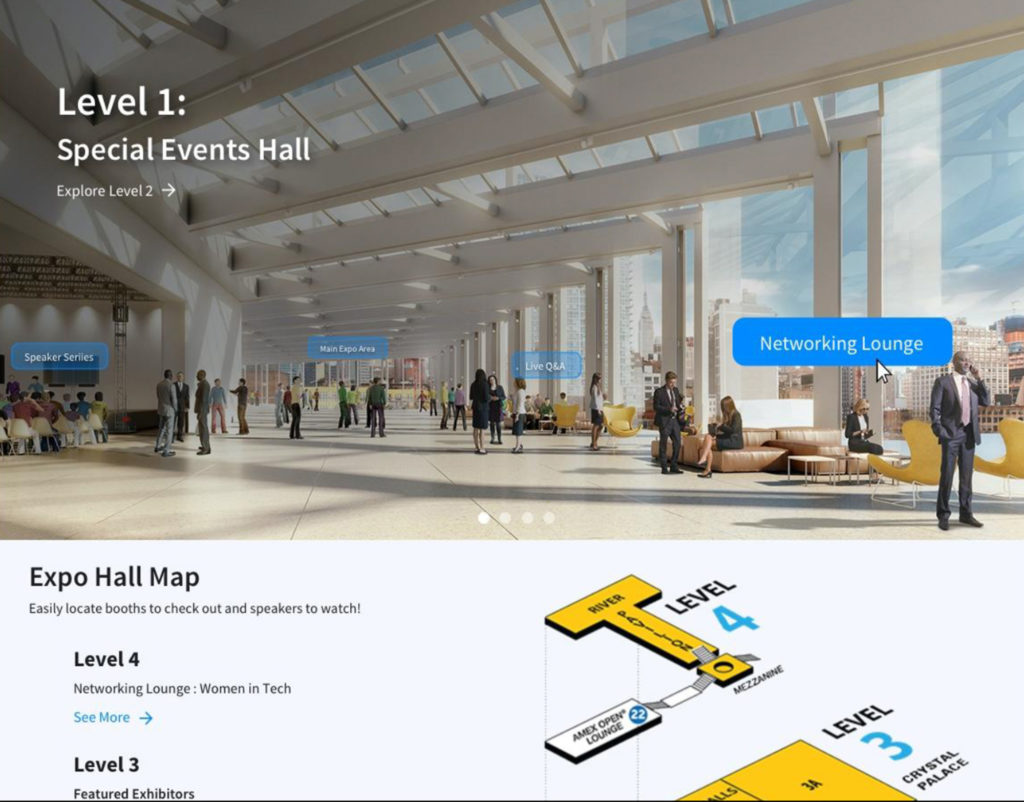21 Dec Hybrid Events – the Best of Both Worlds

Thanks to the COVID-19 pandemic, virtual events have shed their niche status and been placed squarely into the spotlight. Now, as the planning of in-person events cautiously resumes, event organizers are realizing the benefit potential of hybrid events. Hybrid combines the best of virtual and in-person event models to expand an event’s reach and create layered engagement across a broader audience.
Much more than just an event with a Twitter feed or Facebook posts, hybrid events blur the lines between in-person and online events. Hybrid events use technology to allow in-person and online attendees to simultaneously participate in the same content and to interact with each other during the event. To make the most of the hybrid event, the savvy planner should consider ways to create an interactive environment at every touchpoint, identifying opportunities to allow participants in-person and online to make meaningful connections. Read on for tips to create a successful hybrid event.
Determine the goals and desired outcome
As with any event, you’ll want to start by determining why you are bringing people together and what you want them to take away from the experience. Is it a training session designed to disseminate new information? Are you attempting to raise awareness of an issue and generate revenue for a nonprofit organization? Maybe your goal is to raise brand awareness and expose participants to new information presented by sponsors and other exhibitors, or create networking opportunities and sales leads? By first determining the goals and outcome, you can begin to decide what components will be needed to reach your goals. A hybrid event is slightly more complex in that you must consider the needs of both in-person and virtual participants while simultaneously looking for points where they can interact.
Identify your audience
Once you’ve determined the goals and desired outcome, identify your target audience. A major plus of hybrid events is that you can reach a wider audience – even a global audience, if desired. While it may be tempting to want to include anyone and everyone, by identifying your ideal attendee, you can craft a richer experience.
Create a hybrid event plan
Planning a hybrid event in some ways can feel as if you are putting on two events simultaneously. In addition to all of the components normally considered as part of planning for an in-person event, you must also consider how to engage participants who will be in attendance virtually.
Technology considerations are key when planning a hybrid event. For instance, if an app is needed to access the event virtually, download instructions may need to be included as part of registration details. Depending on the tech-savviness of your audience, you may also need to build in special components to ensure all of your participants have a great experience – staff to operate the technology, detailed instructions emailed in advance, or even an online training session prior to the event.
Of course, you’ll need to determine which platform offers the features needed to accomplish your goals and outcomes. If your event includes Q&A sessions, your platform will need to offer the ability for virtual participants to engage with in-person presenters. If breakouts are part of the event, be sure your platform can accommodate separate sessions that allow for live conversations or, at minimum, input via chat. Your platform will also determine the number of participants allowed to attend virtually—at the main event and at any breakouts.
When choosing a platform, also consider how it can make your virtual participants feel as if they are part of the action. Does it offer showroom tours? Does the technology also allow for virtual participants to check-in at each showroom booth? If your event is about training, idea generation, or raising brand awareness, does the platform offer “voting” options or ways for virtual participants to provide input in real-time? If your goal is to offer networking opportunities, does it allow for participants to communicate one-on-one between the live and virtual locations?
Plan for staff and capabilities
Technology management is a key consideration: What are your staff capabilities? In addition to the responsibilities assigned to staff taking care of the in-person event, you’ll also need separate staff to manage the virtual component to ensure that portion of the event runs smoothly.
As part of their roles, the tech members of the team may also be responsible for ensuring that slides, videos, or other add-on components are prepared, loaded, and tested prior to the event. The tech team will also coordinate virtual components such as rotating screens, pop-ups of information, and other elements to keep the virtual community engaged. Tech facilitators and live moderators should also work in tandem to regularly acknowledge the online participants at the event.
Consider inclusion when planning activities
Whatever activities the live portion of your event includes, consider ways to also engage your virtual participants. For instance, consider games or activities that allow live attendees to participate via the same apps that virtual attendees are using. Physical activities, such as fundraising auctions, can also come with both live and virtual components. While in-person participants can actually see the items on display, online photos and information can allow virtual participants to view the items up for bid. If the event includes a theme, consider sending décor items to virtual participants to use in adorning their backdrop.
Pre-shipping or arranging the delivery of meals or other experiential items to virtual participants can be an effective way to increase not just engagement but also sponsorship options. In addition to swag bags and themed or branded items, there are numerous options today for including virtual participants in meals – from wine and cheese boxes to boxed lunches and multi-course dinners – using a fulfillment or food delivery service.
Coach virtual participants
If you’re dealing with less tech-savvy virtual attendees, consider coaching them. This can include providing basic tips for appearing on camera, such as proper attire, decluttering the background, or using a digital backdrop. Another area to consider is on-screen etiquette, such as avoiding unnecessary interruptions, muting and unmuting the mic, and even eating and drinking on camera. By helping your virtual attendees be more comfortable with their participation, the event can be more meaningful for everyone involved.
Follow up after the hybrid event
As with other events, follow-up is no less important with a hybrid. Ideally, with hybrid events, you’ll be able to marry the data from the in-person and virtual components to have even richer information for use post-event. Whenever possible, make content available for use on-demand after the event.
When it comes to hybrid events, a little extra planning and consideration can make all the difference. By taking into consideration the needs of both audiences – live and online – you can put together an event that resonates with the audience however they choose to attend.

Jennifer D. Collins is the founder, President, and CEO of JDC Events. She is a Certified Meeting Professional (CMP), Digital Events Strategist (DES) and well known events industry thought leader. She is Vice Chair of the Board for WBEC Metro NY and WBEC Greater DMV, a member of the Women’s Presidents Organization (WPO), and the Author of Events Spark Change: A Guide to Designing Powerful and Engaging Events.



